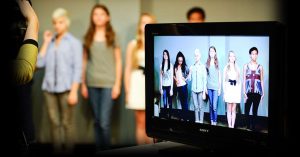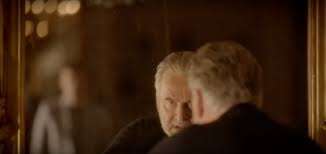Whether an actor playing a role or a contributor representing themselves, no one simply walks onto the television – they are cast. For television drama, the decision is usually made by formal audition, attended by selected actors. But factual programmes such as reality and documentary pluck their onscreen talent from the general population, with the aspiration to reflect the full diversity of people that exists beneath the humdrum of everyday life.
The notion of democratization lies at the very heart of the Public Service Broadcasting, and has done since its inception in 1922. General Manager and founding father of the BBC John Reith envisioned this new technology as an efficient way of informing and educating the wider British public, giving the working class a chance to become part of the important decision-making process which had previously reserved for the country’s elite. But the true reach and nature of this democratization was later challenged by the accusation that Reith had imposed middle-class values on the working class, only a minority of whom could even afford a radio or television set.
In a modern day society where the class-system has supposedly been eradicated, contemporary culture has perhaps become more inclusive – but the boundary between classes still lingers. The development of new media allows further erosion of these barriers through easy online access and the continuous interactivity demanded by social media. There is of course a notion that certain forms are the preference of the younger and lower-class demographic, particularly Instagram, Snapchat, Twitter and Facebook. But with the rising popularity of social media and its integration into everyday life, there has also been an opportunity to demolish any remaining class obstacles and open direct dialogue between broadcasters and their viewers in a radically different way.
Finding characters who will first captivate their audiences and shape a compelling narrative is the dogged pursuit of every factual Casting Producer or production team. The X-Factor team have dug out and packaged their contestants’ sob stories long before they are ever confessed to the nation, expectant couples have been vetted, accepted or rejected for every episode of One Born Every Minute, and our eyes water at how many applications the casting team of First Dates must have to go through, before deciding which love-hopefuls will walk through Fred’s door. The payoff to all this effort? Great casting contributes to great ratings and even returning series; whilst great series lead to reputational and financial rewards for broadcaster, production company and staff.
The first episode of this year’s Love Island attracted 3.4 million viewers as well as the accolade of being ITV2’s highest ever overnight rating, arguably built on widespread obsession with Kem and Amber’s romance last year. Channel 4 repackaged My Big Fat Gypsy Wedding (2010) from a ‘Cutting Edge’ single, to 4 series success with an international spin-off, after over 6 million of us tuned in to gawp at extravagant brides and even more excessive bling.
But for a TV star to be born, they first need to be found and selected; they need to be cast. In the early noughties, production company walls were still adorned with shelves of Yellow Pages and BT Phonebooks and the internet was just a fast way of tracking down a telephone number. Casting was often done by putting out a call-to-arms in the places thought potential contributors were most likely to hear it, such as shadowing hospital shifts to meet a selection of doctors and nurses, or a poster on the noticeboard of a nursery for a stressed-out new parent. But such methods were largely scatter-gun and required intensive casting time, volume and effort to reach enough people from which a ‘TV gold’ contributor could be cast.
 Fast-forward to the present-day’s connected world, where large communities gather online through Facebook groups or are rallied behind a simple #hashtag, and factual television’s casting doors have been blown open. The ease, scope and speed of accessing potential contributors through their digital lives has radically altered with the technology that enables it. This is part of a general trend of the ‘everything-at-once’ era of box-set and online streaming service provision, which has created the conditions for a shift from asynchronous to synchronous media. The capture of material on film and its transmission is as short as possible, to fully exploit social media interactions by audiences, which in turn provide content for more ‘traditional’ news media.
Fast-forward to the present-day’s connected world, where large communities gather online through Facebook groups or are rallied behind a simple #hashtag, and factual television’s casting doors have been blown open. The ease, scope and speed of accessing potential contributors through their digital lives has radically altered with the technology that enables it. This is part of a general trend of the ‘everything-at-once’ era of box-set and online streaming service provision, which has created the conditions for a shift from asynchronous to synchronous media. The capture of material on film and its transmission is as short as possible, to fully exploit social media interactions by audiences, which in turn provide content for more ‘traditional’ news media.
In the asynchronous era, whilst approaching a charity for participants might have yielded two potential ‘leads’ in a month, Casting Assistant Producer Emma Wren has described to us how a recent Facebook post resulted in 40 applications overnight. Social media has allowed factual television producers to access a pool of people with a level of instantaneity, which has never been seen before. It follows then that greater choice, with more representative voices and perspectives are inevitably making it onto our screens.
 At the tail-end of broadcast, social media commentary from viewers also gives detailed insight into which programmes are capturing the trends and feelings of the nation, information that BARB data could only previously hint at en masse. From a one-way transmission to a two-way conversation, social media platforms have enabled channels to shape their commissioning decisions in response to what they can see both resonates and rates with their audience. Spin-out formats such as ITV’s The Voice Kids have sprung up based on the social media commentary of its close relation, The Voice, and shows like Big Brother’s Little Brother act as a means to gather-up social media commentary, re-framing and re-representing it as broadcast material for wider dissemination on screen.
At the tail-end of broadcast, social media commentary from viewers also gives detailed insight into which programmes are capturing the trends and feelings of the nation, information that BARB data could only previously hint at en masse. From a one-way transmission to a two-way conversation, social media platforms have enabled channels to shape their commissioning decisions in response to what they can see both resonates and rates with their audience. Spin-out formats such as ITV’s The Voice Kids have sprung up based on the social media commentary of its close relation, The Voice, and shows like Big Brother’s Little Brother act as a means to gather-up social media commentary, re-framing and re-representing it as broadcast material for wider dissemination on screen.
The concept of populism as a way of appealing to ‘the people’ in a binary opposition to ‘the elite’ by the mainstream television industry, could be seen as exploitative of ordinary people rather than democratic. However, we would argue that this is a two-way affair, which indicates a developing sophistication and cynical awareness on the part of the audience. But there’s no doubt that this evolving alliance between new and traditional media has created a new kind of platform, one which is more inclusive, more relevant and better equipped to reflect society at large.
Hayley Sarian is a Lecturer in Television Production at Bournemouth University, UK, and worked in prime-time factual television for 14 years as a producer, director and development executive.
Peri Bradley is Senior Lecturer in Media Theory at Bournemouth University, UK, specializing in Reality TV, gender and feminism.
Richard Berger is Associate Professor and Head of Research and Professional Practice, Bournemouth University, UK.








